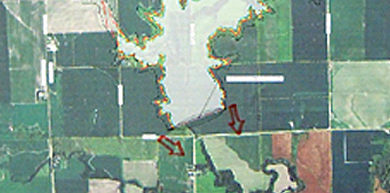SENDD asks what can be done to improve rural economy
SENDD (Southeast Nebraska Development District) introduced the results of a comprehensive economic development strategy (CEDS) last week to Fillmore and Thayer County economic development leaders. The assessment was prepared by the Center for Rural Entrepreneurship.
The two interested parties came together under one roof to discuss their similar profiles in economic development. SENDD representative Kevin Burnison said the two counties meeting together held a double advantage, “because we’ve been told we need to look beyond our borders,” he said and added that SENDD plays a soft second – provides opportunities such as the two-county meeting, and gives options in helping local leaders recognize and create solutions for county-specific issues.
The CEDS report indicates Thayer County has a diversified and strong economy that has been performing well; however, chronic and severe depopulation is undermining the county and its future. It’s a situation calling for aggressive development to first stabilize and then enable moderate population growth, the report said.
“The time may have come when the county should focus serious resources and efforts on a targeted people attraction strategy,” the report added, and suggests economic leaders visit SENDD’s electronic library for “People Attraction Guides” to find a starting point for the county in exploring a population renewal game plan. “There are likely job and career opportunities that could support more residents,” Burnison said, and suggested economic leaders reach out to their areas in search of answers. “It’s tough grinding work,” he said, “and you really can’t tell if you are making much of a difference.” The county has seen a 17 percent decline in population since 1970.
In the meantime, Burnison of SENDD, is visiting with economic leaders to walk them through the report’s findings.
Business retention and expansion are also targeted areas for Thayer County, the Center for Rural Entrepreneurship reports, and suggests economic development leaders focus their efforts on retaining those businesses already here and helping new ones entering the market by asking what is important to them when it comes to maintaining their businesses.
“In both Fillmore and Thayer counties, we have succession and transition issues,” Burnison said. “There is no one to take over an established business, so the business closes its doors.” The CEDS report showed that the last decade suggested there is a new crop of self-employed entrepreneurs within Thayer County and Burnison said the economic leaders needed to find out who they are and how to help them become more successful and involved in their communities thus enabling a new generation of businesses in the county.
According to the report, businesses should cater to retirees in order that they retire and stay as opposed to retire and leave. Retirees are one of Thayer County’s anchors, along with farming, government, manufacturing, and wholesale trade (likely tied to both farming and manufacturing). “We need to pay attention to the baby boomers, see what would make them stay in regard to housing, health care, shopping and entertainment,” Burnison said. “We want them to stay here.”
And finally, Thayer County reflects a rooted wealth in the county tied to agricultural real estate and closely held family business suggesting significant opportunity for community giveback and the creation of community endowments. “Development of these endowments could provide important funding for both community betterment projects and economic development,” the report states.
While the meeting’s main objective for the evening was more or less a planning exercise, the presented CEDS report highlighted several key issues for economic development in the county. All supporting research and analysis for the assessment is available in the Center’s online library at http://bit.ly/tgD2Y5. Research in the electronic library provides expanded analysis: demographics, the local economy, businesses, agriculture and trade capture.



